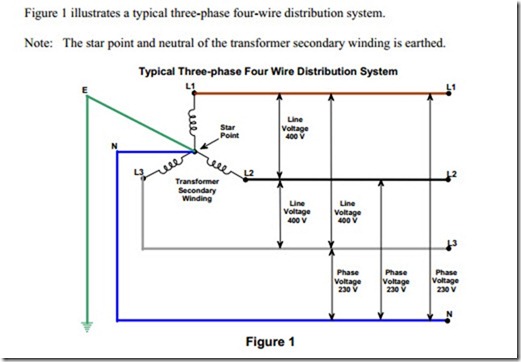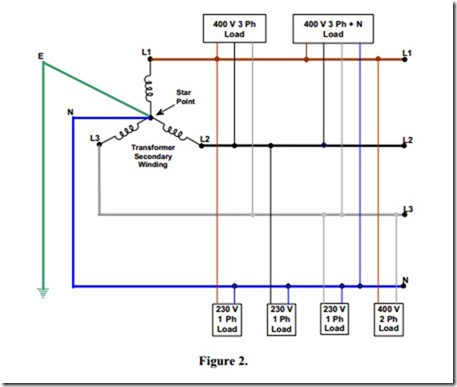Three-phase Supplies
The mains 400 / 230V supply is derived from a substation transformer. The transformer secondary windings are connected in star as shown in figure 1. The star point provides a neutral for the system. The star point is earthed by the Supply Authority.
Three-phase Four Wire Distribution System
Figure 1 illustrates a typical three-phase four-wire distribution system.
Note: The star point and neutral of the transformer secondary winding is earthed.
Typical Three-phase Four Wire Distribution System
Phase Voltage ( UPh )
This is the voltage of each phase conductor with respect to the neutral conductor. It is illustrated in Figure 1. The value of each phase voltage is 230 Volts AC ( RMS ).
Line Voltage ( UL )
This is the voltage between any two lines ( e.g. between L1 and L2, L1 and L3, L2 and L3 ). It is illustrated in Figure 1. The value of each line voltage is 400 Volts AC ( RMS ).
Three-phase Supply in Commercial / Industrial Premises
A 3-phase 400 Volt four-wire supply is used for industrial and commercial loads. Industrial loads usually demand more power than domestic loads and more power can be supplied by a 400V three-phase supply than is possible with a 230V single-phase supply.
It is possible to take the following supplies from a 3-phase 400 Volt four-wire system.
· 3-Phase 400 Volt 4-Wire supply, which is used for unbalanced 3-phase loads as they require a neutral.
· 3-Phase 400 Volt 3-Wire supply, which is used for balanced loads such as 3-phase motors or 3 phase heaters, which do not require a neutral.
· 2-Phase 400 Volt 2-Wire supply, which is used for loads such as some welders, ( correctly referred to as a 1-Phase 400 Volt supply ).
· 1-Phase 230 Volt supply, which is used for loads such as lamps, heaters, computers.

